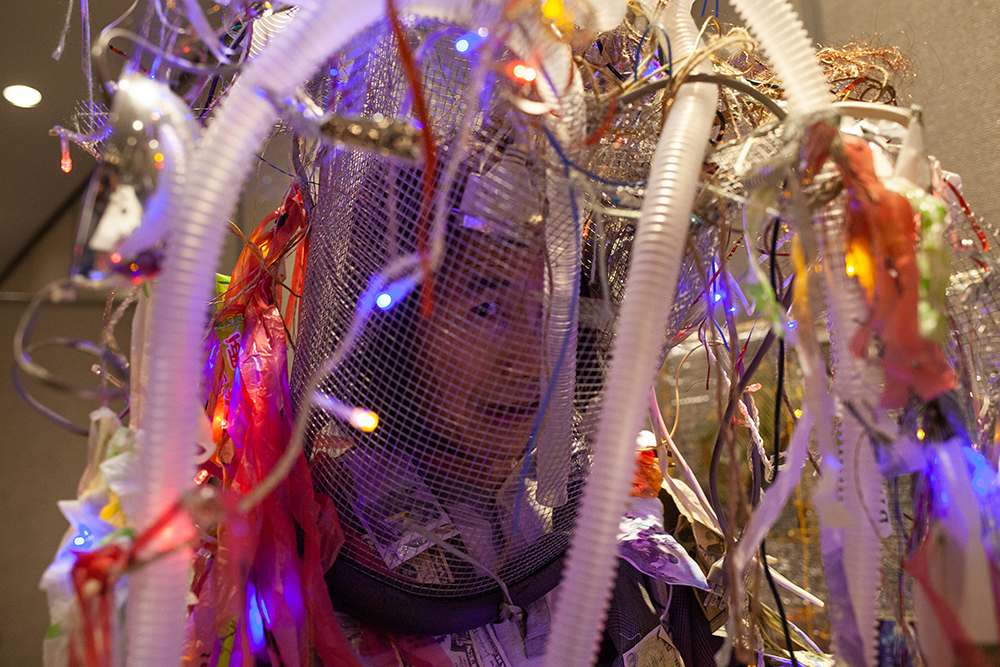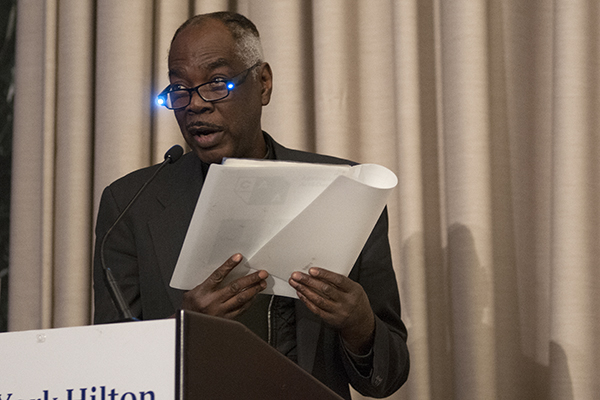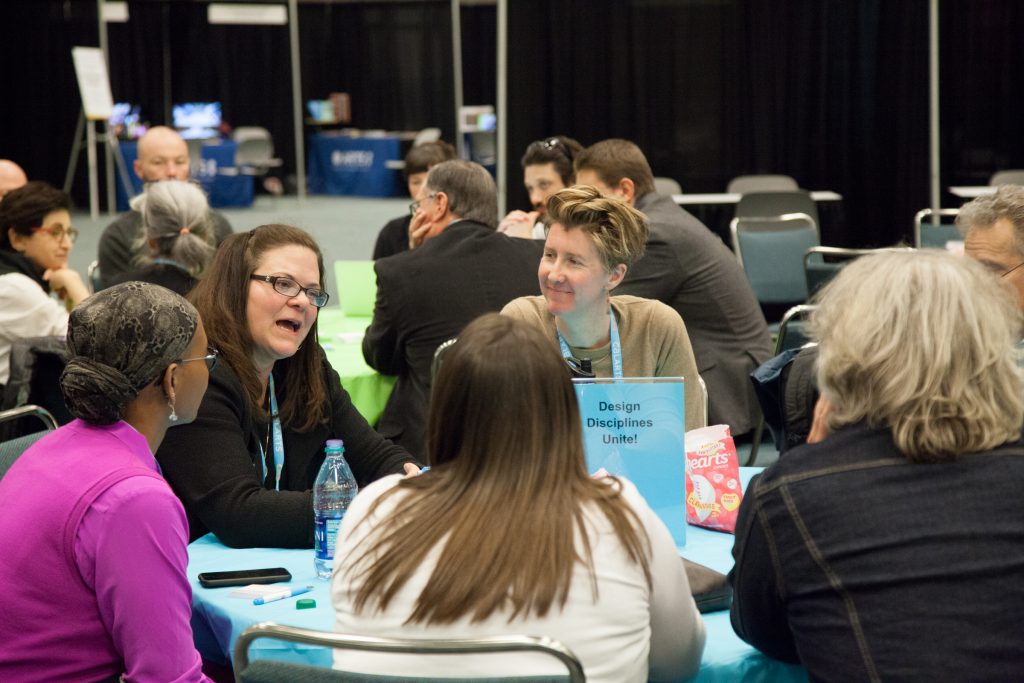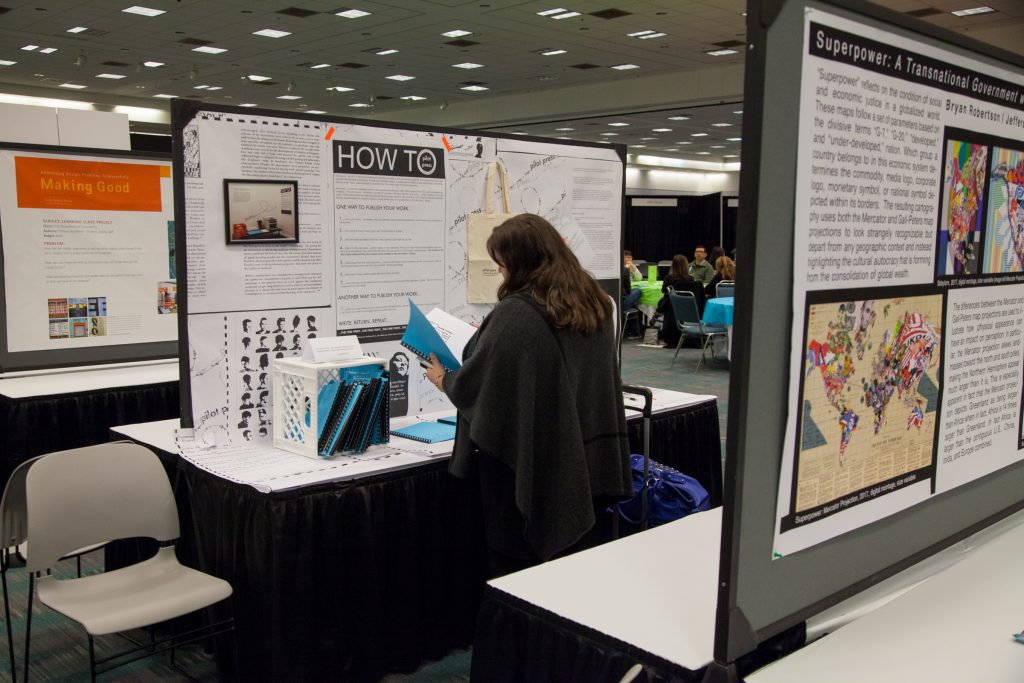CAA News Today
Call for Submissions: CAA 2020 MFA Screening
posted by CAA — November 20, 2019
CAA’s Services to Artists Committee (SAC) invites MFA students to submit video work for consideration for the upcoming CAA 108th Annual Conference in Chicago in February 2020.
Selected works will be premiered during the conference in the Media Lounge on Wednesday, February 12, 12:15–1:45 PM, and screened during the conference at the ARTexchange exhibition, which will be presented at the Hokin Gallery at Columbia College (623 South Wabash), a half block north of the conference hotel.
Through this screening and exhibition initiative, SAC aims to welcome the next generation of artists and practitioners into our midst. Our annual MFA Screening celebrates the hard work of MFA students across the nation and world, while exposing their artworks to a broad audience. We look forward to reviewing your submissions.
Please use the form here or the button below to submit your entry (a maximum of three per participant).
Deadline: December 10, 2019
Submission for consideration is free, and membership with CAA is not required (we are collecting that information for statistical purposes).
Jurors: Joan Giroux, Richard Serrano, and Vagner Mendonça-Whitehead
Submissions should include the following:
- A short bio (50 words or less)
- A short artist statement (100 words or less)
- A link to 1–3 videos
- Personal website (optional)
Specifics for your submissions:
- 5 minutes in maximum length (excerpts accepted)
- mpeg 4
- 720p
- Slate/Title cards: 5 seconds, with your name, title of work, date of completion, name of school/program
- uploaded onto Vimeo.com (upload your link, allow it to be download-able)
Deadline: December 10, 2019
Acknowledgment: January 15, 2020
In collaboration with the Committee on Women in the Arts, CAA offers 50 percent of the 2020 conference’s content in celebration of the Centennial of Women’s Suffrage in the United States, while also acknowledging the discriminatory practices that limited voting rights for Indigenous women and women of color, even after the passage of the 19th amendment in 1920. The Services to Artists Committee encourages applicants to embrace the spirit of the 2020 conference by engaging issues of inclusivity and intersectional discourses in the arts.
About us: The Services to Artists Committee (SAC) was formed by the CAA Board of Directors to seek broader participation by artists and designers in the organization and the Annual Conference. SAC identifies and addresses concerns facing artists and designers; creates and implements programs and events at the conference and beyond; explores ways to encourage greater participation and leadership in CAA; and identifies ways to establish closer ties with other arts professionals and institutions. To this end, committee members are responsible for the programming of ARTspace and its related events.
Deadline extended! Annual Conference Committee Seeks Members
posted by CAA — November 12, 2019
CAA invites nominations and self-nominations for two at-large members of the Annual Conference Committee to serve a three-year term. Terms begin February 2020, immediately following the 108th Annual Conference.
The Annual Conference Committee, working with the CAA Programs Department, selects the sessions and shapes the program of the Annual Conference. The committee ensures that the program reflects CAA’s goals for the conference, namely, to make it an effective place for intellectual, aesthetic, and professional learning and exchange; to reflect the diverse interests of the membership; and to provide opportunities for participation that are fair, equal, and balanced.
The Annual Conference Committee meets during the conference and at the call of the program chair and vice president for Annual Conference. Committee members also serve to support sessions comprised of individual papers and projects where a formal chair has not been identified.
Please send a 150-word letter of interest and a CV to Mira Friedlaender (mfriedlaender@collegeart.org), CAA manager of annual conference.
Deadline (extended): February 18, 2020
An Interview with Kellie Jones, 2020 CAA Distinguished Scholar
posted by CAA — October 28, 2019
We are delighted to welcome Dr. Kellie Jones, professor in Art History and Archaeology and the Institute for Research in African American Studies (IRAAS) at Columbia University, as the Distinguished Scholar for the 108th CAA Annual Conference in Chicago, February 12-15, 2020.
Dr. Jones, whose research interests include African American and African Diaspora artists, Latinx and Latin American Artists, and issues in contemporary art and museum theory, is the recipient of awards from the Hutchins Center for African and African American Research, Harvard University, Creative Capital, and Warhol Foundation, among others. In 2016, she was named a MacArthur Foundation Fellow. In 2018, Dr. Jones was the inaugural recipient of the Excellence in Diversity Award from CAA.
CAA media and content manager Joelle Te Paske spoke with Dr. Jones earlier this fall to learn about what she’s working on and looking forward to in upcoming exhibitions and scholarship. Read the interview below.
This interview has been edited for length and clarity.
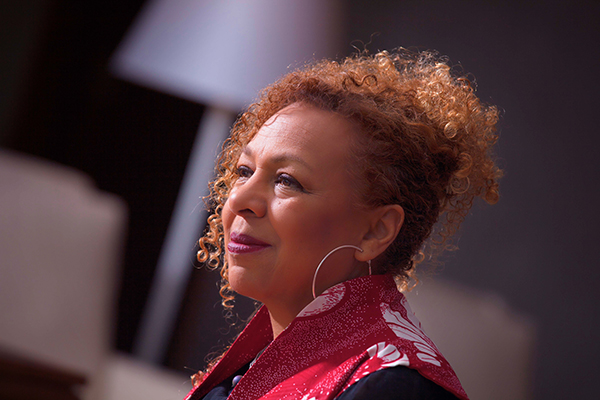
Dr. Kellie Jones. Photo: Rod McGaha
Hi, Professor Jones. Thank you for taking the time for this interview. It’s an honor to speak with you and we’re excited that you’ll be with us in Chicago.
I’m looking forward to it.
Great. So to begin—to locate ourselves in time and place—how are you? How was your summer?
It’s always fun, and it always ends too quickly. I think that’s just normal. [Laughs]
Yes, I guess that’s where we should be at this point [laughs]. Were you working on a particular project this summer?
Yes. I was working on a project for Center for Advanced Study in the Visual Arts (CASVA). Huey Copeland of Northwestern University and Steven Nelson of UCLA are spearheading a Black Modernisms seminar with a group of scholars. I just finished an essay on the Harlem Renaissance that is still to be titled. I haven’t written extensively on that period so I’m really looking forward to hearing back from them. It involves race and gender and I’m very excited about it.
What else is exciting in your work right now?
Candida Alvarez: Here, A Visual Reader (Green Lantern Press 2019), the first major monograph on the Chicago-based painter, is about to hit shops. I’m excited by this project to which I contributed the essay, “When Painting Stepped Out to Lunch.” I have book that I’m finishing on global conceptual art networks that is tentatively titled Art is an Excuse, on how conceptual art allowed for different types of global connections. One great example is Senga Nengudi and her relationship to Japan which is something I’ve written about earlier but I wanted to more forthrightly connect to Japanese conceptualism. So how does Senga Nengudi fit into that dialogue, or what is her dialogue? I’m thinking about conceptual art as a motor for global art connection, different from what people call globalization—more like artist dialogues, not neoliberal globalization.
A macro view.
The book is more about relationships. We always think about artists in their particular nationalist space. What did Japanese conceptualism look like? What did Latin American conceptualism look like? How were they different? But we really don’t talk about the kind of dialogue that people have with each other. That’s really the whole premise of the project.
That’s terrific. I read that for undergrad at Amherst College you made an interdisciplinary major. I was going to ask: Has an interdisciplinary outlook been formative in your career? But I feel you’re already embodying that.
You’re absolutely right. I created an interdisciplinary major at Amherst. Shout out to my alma mater and to liberal arts education.
We love that at CAA, yes.
And we love it because it allows people to see the breadth of the world in some fashion and then choose something or choose a few things. I’m one of the people that thought about Latin American and African American and Latinx artists at least from my college years, and I’ve been going with that for the longest, along with ideas of the African diaspora. You might start out with “Let’s compare”—the comparative structure; the binary is such a signature of art history. But then you realize that it’s so much more than a just a binary—the interdisciplinarity, the multidisciplinarity. That’s always been a part of what I’ve looked at because at that time—and I know I’ve said it on numerous occasions in numerous platforms—art history was really taught one way. Because I had grown up in New York I said, “But wait a minute, they’re leaving out all of these people that are making art that I know!” That I see every week. I mean, how is that possible? So I started there and just kept going.
I also read that you wanted to be a diplomat originally, and that makes sense to me. I think art historians are often part-diplomats, part-detectives, part-scientists. There’s so much that goes into the field.
Absolutely. I wanted to get away from art. I grew up with artists and poets and I said, “Oh my god, these people are broke. I can’t do that.”
Well, that’s realistic—I suppose it’s changed, too.
It’s absolutely changed, but if you’re thinking about late 1970s—wow. People weren’t even thinking about objects too much.
Someone reminded me much later—maybe a couple of years ago—they said, “Well you know, you’ve been doing [diplomacy] with art. You’ve been a cultural ambassador with this work, because you’ve done shows around the world.” Art history became, “Wow, you can do the same things.” You can study languages. You can travel. It did become a way you could do all those things, and then of course as you just mentioned, as a curator you are a diplomatic entity between artists and the institution.
As a liaison, definitely. It’s sensitive.
Right. Even as an academic, if you’re traveling around or if you’re representing a contemporary artist in your writing—how do you balance how the artist sees themselves with what you have to say? There’s always that.
I’m curious what you see as emerging trends in scholarship, especially in art history.
I think students and academics—particularly a new generation—don’t want traditional art history as we have known it. They want a more interdisciplinary, multidisciplinary, global understanding of art in the world. Art history is not just Europe, and it’s not just the United States. And the art of the United States meaning not just New York!
I think the other really exciting arena is, of course, gender. Gender studies. Queer studies in art history. Trans studies. All those things really change how we understand the object, how we understand history, the histories that we look for. There’s a similarity to the discoveries that I made when I was a student in college about how art history at that time did not represent even the histories of African Americans who were in New York, for instance. United States art history is written from a New York-centric perspective. And at that time, you didn’t see too many women in it. You didn’t see too many African Americans or Latinx figures. So now that such subjects are more widely known the next step seems to be to ask,”What is a queer art history?” And some people have been doing this for a while: Jonathan Weinberg, James Smalls, Julia Bryan-Wilson has brought us into the present with some of these ideas, and C. Ondine Chavoya with his Axis Mundo, project. So all these ideas are becoming more visible and I think it’s really exciting.
That’s one of the reasons why I’ve been so keen on my Harlem Renaissance article. It started out in one way, and then it took me in another direction; it takes another look at objects that have been dismissed as not being relevant, and sees them through a different lens. It opens up other paths into these works that have been discarded. Or maybe not discarded, but put to the side. Let’s ask, “What’s going on with gender in these works?” What’s going on with queerness, and how do they signify to a Harlem Renaissance that is quite queer? It’s something people in literature have discovered, certainly in the African American context, and they’ve been talking about that for years. Art history has to catch up.
Yes, you feel a real energy in the field, a real hunger for it. With recent protests around Warren Kanders at the Whitney Museum, what are your views on that momentum? [Editor’s note: Since this conversation took place, Warren Kanders announced his resignation from the Whitney Museum board.]
Well, you know, there have always been protests at US museums as well as those around the world. So whether you are a curator or a director who bares the brunt of the protest, or you are an artist who withdraws, you’re part of history. Scholars down the road are going to say, “These people pulled out. These people wrote a letter. These were the curators. These were the board members.” So for me it’s just part of history, and it has ebbs and flows. There are a lot of things going on in this world that artists are addressing, that artists see. They do respond to the world in one way or another. You may not see it visibly, but it’s there.
I agree. I think putting new ideas in the world the way artists do is cultural change, and like you said—it’s interconnected. You can’t really have one without the other.
Yes. It’s part of a larger history.
When did you first join CAA? Do you have a favorite memory from a conference?
I had joined CAA by 1990, when I served as the co-chair of the programming at the Annual Meeting for the Studio or Artists’ sessions with Robert Storr. I’ve been on plenty of panels since then, but to be honored in this way is humbling and exciting. Even better, all of the respondents I asked to participate on the Distinguished Scholar panel said, “Yes! I’ll be a part of it.” So I’m thrilled about that. I’ve been at Columbia University about 13 years, and I remember when Rosalind Krauss was honored, and I participated in Richard J. Powell’s Distinguished Scholar panel. So to step into those shoes, it seems a bit surreal.
Thinking of Chicago in 2020—do you have a favorite art-related excursion there?
Well, the South Side Community Art Center is legendary. It’s one of the original community art centers from the New Deal era, and it’s still in existence. I would definitely say go to that. That’s my favorite.
I’m marking it down for myself. Are there exhibitions coming up this fall that you recommend?
Senga Nengudi at Lenbachhaus in Munich; Robert Colescott at the Contemporary Art Center in Cincinnati curated by Lowery Sims and Matthew Weseley; Lynette Yiadom-Boakye at Yale Center for British Art curated by Hilton Als; Hank Willis Thomas: All Things Being Equal…, his first major survey at the Portland Art Museum. Curator Meg Onli at ICA Philadelphia has done a trio of shows under the title Colored People Time. The final component Banal Presents will be on view through December 22, 2019.
Shows that are further out that I’m excited about are Prospect 5 in New Orleans (Fall 2020), curated by Naima Keith and Diana Nawi. The citywide triennial in New Orleans is just a great experience. Everyone should check it out. Thomas Lax’s exhibition on Just Above Midtown gallery, that generative space of 1970s and 1980s, and its founder Linda Goode Bryant, will be wonderful to see at MoMA in 2022.
There are so many great young curators out here. Rujeko Hockley, Erin Christovale, numerous others. Tiona Nekkia McClodden is an artist who’s been doing some great archival curatorial work. She had a show that was in response to the anniversary of Mapplethorpe’s The Perfect Moment that just closed. There are just so many great people out here doing some wonderful things, and a lot of wonderful younger artists. I’m excited by it. We started out by talking about multidisciplinarity, interdisciplinarity—young curators are invested in that idea as much as scholars.
Oh and one thing that I’m really looking forward to down the line is, of course, the reopening of the Studio Museum in Harlem. I cannot wait for that!
Yes! It’s a ways off but that’s an exciting one. Well, thank you Dr. Jones. I appreciate you taking the time, and it’s been a pleasure to speak with you.
Thanks for your questions, and again it’s really an honor to be a part of this whole thing. I still kind of can’t believe it. I guess I will in February when I step off that plane!
The Distinguished Scholar Session honoring Kellie Jones will take place Thursday, February 13, 2020, from 4-5:30 PM at the Hilton Chicago, Grand Ballroom.
Biography of Dr. Kellie Jones
Dr. Kellie Jones is a Professor in Art History and Archaeology and African American and African Diaspora Studies at Columbia University. Her research interests include African American and African Diaspora artists, Latinx and Latin American Artists, and issues in contemporary art and museum theory.
Dr. Jones, a member of the American Academy of Arts and Sciences, has also received awards for her work from the Hutchins Center for African and African American Research, Harvard University and Creative Capital | Warhol Foundation. In 2016 she was named a MacArthur Foundation Fellow.
Dr. Jones’s writings have appeared in a multitude of exhibition catalogues and journals. She is the author of two books published by Duke University Press, EyeMinded: Living and Writing Contemporary Art (2011), and South of Pico: African American Artists in Los Angeles in the 1960s and 1970s (2017), which received the Walter & Lillian Lowenfels Criticism Award from the American Book Award in 2018 and was named a Best Art Book of 2017 in The New York Times and a Best Book of 2017 in Artforum.
Dr. Jones has also worked as a curator for over three decades and has numerous major national and international exhibitions to her credit. Her exhibition “Now Dig This! Art and Black Los Angeles, 1960-1980,” at the Hammer Museum, Los Angeles, was named one of the best exhibitions of 2011 and 2012 by Artforum, and best thematic show nationally by the International Association of Art Critics (AICA). She was co-curator of “Witness: Art and Civil Rights in the 1960s” (Brooklyn Museum), named one the best exhibitions of 2014 by Artforum.
Sign Up for Childcare at the 2020 Annual Conference
posted by CAA — October 16, 2019

Please note: Due to low enrollment, onsite childcare for the 2020 Annual Conference has been canceled. To better meet members’ childcare needs, we are now offering Childcare Grants of up to $250 per family. Learn more and apply here.
For the second year in a row, we’re pleased to partner with Kiddie Corp to offer onsite childcare at the Annual Conference.
Care will be available for ages 6 months to 12 years of age, at a rate of $12 an hour, on Thursday, February 12 and Friday, February 13, 2020, from 8 AM – 8 PM.
Kiddie Corp programs feature arts and crafts, group games, music and movement, board games, story time, dramatic play, and many more engaging activities. Kiddie Corp is in its 33rd year of providing childcare services at conferences and trade shows and has a longstanding partnership with the American Academy of Pediatrics.
Conference attendees in need of childcare during the conference should pre-register for care. A minimum number of children must register for the service by December 3rd in order to allow CAA to offer onsite childcare in the Hilton Chicago. Please note: If we do not have enough enrollment, onsite childcare will be canceled.
Sign up deadline: December 3, 2019
Deadline Extended! Participate in ARTexchange at CAA 2020
posted by CAA — October 04, 2019
Originally formatted as a pop-up exhibition and meet-up event for artists and curators, ARTexchange provides an opportunity for artists to share their work and build affinities with other artists, historians, curators, and cultural producers at the Annual Conference.
This year, instead of a one-time event, ARTexchange invites artists to lead participatory projects and/or workshops over the duration of the conference with a culminating public reception on Friday, February 14, from 7-8:30 pm.
CAA’s Services to Artists Committee, in collaboration with the Hokin Project, a gallery management practicum course at Columbia College Chicago, seeks proposals from artists to lead participatory projects and/or workshops for ARTexchange.
ARTexchange projects and/or workshops will take place at the Columbia College Hokin Gallery, from February 12-15, 2020. The gallery is located a half block north of the Hilton Chicago conference hotel at 623 South Wabash. The work created will remain on exhibit through February 24, 2020. Proposals that include community engagement and meaningful interaction with CAA, Columbia College, and Chicago communities will be prioritized.
In collaboration with the Committee on Women in the Arts, CAA offers 50 percent of the 2020 conference’s content in celebration of the Centennial of Women’s Suffrage in the United States, while also acknowledging the discriminatory practices that limited voting rights for Indigenous women and women of color, even after the passage of the 19th amendment in 1920. The Services to Artists Committee encourages applicants to embrace the spirit of the 2020 conference by engaging issues of inclusivity and intersectional discourses in the arts.
Artists will have access to found objects or recycled materials donated and sourced that might include such things as office supplies, paper, fabric, paint, or drawing materials. A risograph with at least eight ink drums is at hand as a possible resource as well. Please consider that activities will take place in a public, open, non-studio environment and should not include toxic materials or processes.
Artists whose proposals are accepted must become CAA members. Complete information on CAA membership is available here.
The Hokin Project is a Gallery Management Practicum course of the Business and Entrepreneurship Department. Graduate and undergraduate students manage all aspects of the gallery to present multi-disciplinary work of the broader Columbia College Chicago community and beyond through programs, events, and exhibitions.
Please email any questions to hokingallery@gmail.com and artexchange2020@gmail.com. Include “CAA ARTexchange” in the subject line.
Deadline to submit (extended): November 8, 2019
- Contact information
- A short narrative bio (150 words or less)
- A short artist statement (150 words or less)
- Website URL (optional)
- A PDF (one file maximum 10 MB) of your proposal detailing your project, including materials requests, technical needs, and how you will engage the community (Chicago, CAA, and Columbia College Chicago) and/or consider inclusivity through the proposal. Please refer to the gallery plan, and if a particular space is preferable for the activity, make a note (please note that space will be shared amongst the accepted projects). If your project might take place over consecutive days, please note below in the Availability section. (up to 500 words)
- Work samples (5–10 images and/or links to 1–2 video/audio files)
- An image description list detailing the title, year completed, medium, and dimensions of each work. You may also include a short description describing how the work relates to the proposed project.
- Availability: your availability during different time slots during the conference and any other information related to scheduling.
Announcing Notable Speakers for 2020 Annual Conference in Chicago
posted by CAA — October 01, 2019
We’re delighted to announce the following guests will be presenting at the 108th CAA Annual Conference, taking place February 12-15, 2020, at the Hilton Chicago.
Keynote Speaker
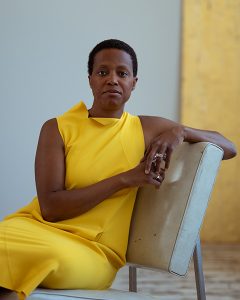
Amanda Williams. Photo: David Kasnic Photography
The Keynote Speaker for the 108th CAA Annual Conference will be Amanda Williams. A visual artist who trained as an architect, Williams’s creative practice navigates the space between art and architecture, through works that employ color as a way to highlight the political complexities of race, place and value in cities. Williams has received critical acclaim including being named a USA Ford Fellow and a Joan Mitchell Foundation grantee. Her works have been exhibited widely and are included in the permanent collections of the Art Institute of Chicago and the Museum of Modern Art in New York. She lives and works on the South Side of Chicago.
CAA Convocation featuring Amanda Williams’s keynote will take place Wednesday, February 12, 2020, from 6-7:30 PM at the Hilton Chicago, Grand Ballroom. Free and open to the public.
Distinguished Scholar
The Distinguished Scholar for the 108th CAA Annual Conference will be Dr. Kellie Jones, professor in Art History and Archaeology and African American and African Diaspora Studies at Columbia University. Her research interests include African American and African Diaspora artists, Latinx and Latin American Artists, and issues in contemporary art and museum theory.
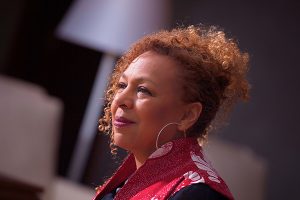
Dr. Kellie Jones. Photo: Rod McGaha
Dr. Jones, a member of the American Academy of Arts and Sciences, has also received awards for her work from the Hutchins Center for African and African American Research, Harvard University and Creative Capital | Warhol Foundation. In 2016 she was named a MacArthur Foundation Fellow.
Dr. Jones’s writings have appeared in a multitude of exhibition catalogues and journals. She is the author of two books published by Duke University Press, EyeMinded: Living and Writing Contemporary Art (2011), and South of Pico: African American Artists in Los Angeles in the 1960s and 1970s (2017), which received the Walter & Lillian Lowenfels Criticism Award from the American Book Award in 2018 and was named a Best Art Book of 2017 in The New York Times and a Best Book of 2017 in Artforum.
Dr. Jones has also worked as a curator for over three decades and has numerous major national and international exhibitions to her credit. Her exhibition “Now Dig This! Art and Black Los Angeles, 1960-1980,” at the Hammer Museum, Los Angeles, was named one of the best exhibitions of 2011 and 2012 by Artforum, and best thematic show nationally by the International Association of Art Critics (AICA). She was co-curator of “Witness: Art and Civil Rights in the 1960s” (Brooklyn Museum), named one the best exhibitions of 2014 by Artforum. Read our interview with Kellie Jones.
The Distinguished Scholar Session will take place Thursday, February 13, 2020, from 4-5:30 PM at the Hilton Chicago, Grand Ballroom.
Distinguished Artist Interviews
The Distinguished Artist Interviews will feature artist Sheila Pepe interviewed by John Corso Esquivel, and artist Arnold J. Kemp interviewed by Huey Copeland.
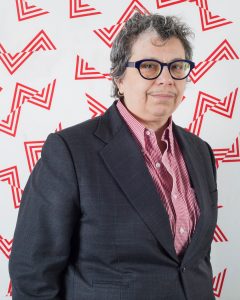
Sheila Pepe. Photo: Rachel Stern
Sheila Pepe is a cross-disciplinary artist employing conceptualism, surrealism, and craft to address feminist and class issues. Hot Mess Formalism, Pepe’s most recent solo exhibition organized by the Phoenix Art Museum, traveled to the Everson Museum of Art, Syracuse, New York; Bemis Center for Contemporary Arts, Omaha, Nebraska; and the deCordova Sculpture Park and Museum, Lincoln, Massachusetts between 2017 and 2019. A catalogue for the exhibition featured essays by by Julia Bryan-Wilson, Elizabeth Dunbar, Lia Gangitano, and curator Gilbert Vicario.
Other texts, all published in 2019, feature Pepe’s work: Vitamin T: Threads, and Textiles in Contemporary Art, the revised Art and Queer Culture by Catherine Lord and Richard Meyer, both published by Phaidon, and Feminist Subjectivities in Fiber Art and Craft: Shadows of Affect by John Corso Esquivel.
Venues for Pepe’s many other solo exhibitions include the Smith College Museum of Art, Northampton, Massachusetts, and the Weatherspoon Art Museum, Greensboro, North Carolina. Her work has been included in important group exhibitions, most recently Fiber: Sculpture 1960- Present, curated by Janelle Porter, organized by the ICA Boston; Queer Abstraction, curated by Jared Ladesema, organized by the Des Moines Art Center in Iowa and Even Thread Has Speech, curated by Shannon Stratton for the John Michael Kohler Art Center, Wisconsin.
John Corso Esquivel is the Doris and Paul Travis Associate Professor of Art History at Oakland University.

Arnold J. Kemp. Photo: Todd Rosenberg for the School of the Art Institute of Chicago
Arnold J. Kemp is an interdisciplinary artist living in Chicago. The recurrent theme in his drawings, photographs, sculptures and writing is the permeability of the border between self and the materials of one’s reality. Kemp’s works are in the collections of the Metropolitan Museum of Art, The Studio Museum in Harlem, The Berkeley Art Museum and Pacific Film Archive, The Portland Art Museum, The Schneider Museum of Art, and the Tacoma Art Museum. He has received awards from the John Simon Guggenheim Memorial Foundation, the Joan Mitchell Foundation, The Pollock-Krasner Foundation, and Portland Institute for Contemporary Art. His work has been exhibited recently in Chicago, Mexico City, New York, San Francisco and Portland. His work was also shown in Tag: Proposals On Queer Play and the Ways Forward at the ICA Philadelphia. Kemp was a founding curator at Yerba Buena Center for the Arts from 1993-2003 and is currently the Dean of Graduate Studies at the School of the Art Institute of Chicago. Read our interview with Arnold J. Kemp.
Huey Copeland is Arthur Andersen Teaching and Research Professor, Interim Director of the Black Arts Initiative (2019-2020), Associate Professor of Art History, and affiliated faculty in the Critical Theory Cluster, the Department of African American Studies, the Department of Art Theory & Practice, the Department of Performance Studies, and the Gender and Sexuality Studies Program at Northwestern University.
The Distinguished Artist Interviews will take place Friday, February 14, 2019, from 4-6:30 PM at the Hilton Chicago, Grand Ballroom. Free and open to the public.
Registration Now Open for the 2020 CAA Annual Conference
posted by CAA — October 01, 2019
2020 CAA ANNUAL CONFERENCE
Hilton Chicago
FEBRUARY 12-15, 2020
Four days for everyone in the arts with over 300 sessions and panels, dozens of receptions and parties, professional development workshops, lightning talks, and exhibitors. #CAA2020
For the first time since 2014, the CAA Annual Conference returns to Chicago in February. We welcome all those in the visual arts to attend over 300 sessions and professional development workshops, as well as dozens of receptions, parties, and special tours at local museums and cultural institutions. The Book and Trade Fair, with over one hundred booths showcasing the latest products, programs, and books, will be on the lower level of the Hilton Chicago. Our partners offering free or discounted admission and special tours this year include Art Institute of Chicago, the Field Museum, the Design Museum of Chicago, and many others.
The 108th CAA Annual Conference content will address the full breadth of the field of visual arts and design and will examine a range of cultures, histories, and scholarship. We anticipate more than 5,000 professionals in the arts to attend the conference in Chicago. In collaboration with the Committee on Women in the Arts, we offer 50 percent of the conference’s content in celebration of the Centennial of Women’s Suffrage in the United States, while also acknowledging the discriminatory practices that limited voting rights for Indigenous women and women of color, even after the passage of the 19th amendment in 1920.
We are excited to announce that several renowned artists, designers, and scholars will be speaking at the conference. On Wednesday, February 12, Chicago-based visual artist Amanda Williams will be delivering the keynote address at Convocation. On Friday, February 14, our Artist Interviews will feature Sheila Pepe and Arnold J. Kemp, and this year’s Distinguished Scholar Session, held on February 13, will honor Kellie Jones.
Learn More about our Notable Speakers
Once again, CAA will offer travel grants and scholarships to individuals looking to attend the Annual Conference. With the generous support of Blick Art Materials and Routledge, Taylor & Francis, CAA will provide eight student member registrants with $250 each to attend the conference.
We look forward to seeing you in Chicago!
Please contact Member Services at membership@collegeart.org or at 212-691-1051, ext. 1 with any questions.
Submit a Proposal for Idea Exchange at CAA 2020
posted by CAA — September 16, 2019
We launched Idea Exchange at the 2018 Annual Conference in Los Angeles in response to members who expressed an interest in holding informal roundtable discussions on topics ranging from fellowship applications and gallery representation to student engagement in the classroom and preserving women artists’ legacies. See a list of previous discussion topics here.
We’re offering Idea Exchange again in 2020 and we’re looking for CAA members to serve as discussion leaders.
Propose a topic that you would like to discuss with your colleagues for a sixty-minute roundtable at the conference. It can relate to professional development, teaching, or current events, such as the debate surrounding Confederate monuments or the #MeToo movement in the arts. Be creative. The conversations are meant to be lively and engaging. Please submit your Idea Exchange proposals by November 1, 2019.
In order to submit an Idea Exchange topic, you will need to have your member ID and password ready. If you do not have an individual ID number and password or you do not know it, please contact member services by email at membership@collegeart.org or by phone at 212-691-1051, ext. 1.
Idea Exchange will be held in the Hilton Chicago, Lower Level, Salon B, during the following times:
Wednesday, February 12: 10:30 AM; 12:30 PM; 2:00 PM; 4:00 PM
Thursday, February 13: 10:30 AM; 12:30 PM; 2:00 PM; 4:00 PM
Friday, February 14: 10:30 AM; 12:30 PM; 2:00 PM; 4:00 PM
Saturday, February 15: 10:30 AM; 12:30 PM
For more information on Idea Exchange, contact Mira Friedlaender, manager of the Annual Conference, at mfriedlaender@collegeart.org or by phone at (212) 392-4405.
Call for Participation: CAA 2020 Poster Session Highlighting Undergraduate Research in Art and Art History
posted by CAA — September 05, 2019
We’re excited to announce a Call for Participation for a special poster session dedicated to undergraduate research for the 2020 Annual Conference in Chicago, February 12-15.
Organized by Alexa Sand, Chair of the Division of Arts and Humanities for the Council on Undergraduate Research, and Professor of Art History and Director of Undergraduate Research at Utah State University, this session is one of several events planned for CAA 2020 to provide more opportunities for undergraduate participation.
Submissions should be sent via this google form by October 31, 2019.
Selected presenters will be notified by December 1 and will need to join CAA at the student membership rate prior to participation in the conference. Participants will also be required to register for the conference.
Undergraduate research—whether part of a faculty-directed project, class-based, or an individual pursuit on the part of a student—is an ideal example of active and engaged learning. Students in art history identify questions, evaluate source material, test ideas and theories, and produce reports in some form, usually including a significant written component. In the studio art and design fields, research can take a different form, with creative practice being one way outcomes of a project can be delivered.
This poster session will be dedicated to presenting outstanding examples of undergraduate research. Submissions are invited from students conducting research such as object and/or medium studies, text-based analysis, experimental archaeology, thesis research, and/or creative inquiry. Students may choose to present findings from ongoing research or from recently completed projects.
We also encourage submissions from faculty and museum professionals who have experience with mentoring undergraduate research in Art History, Studio Art, Graphic Design, Visual Communication, and other creative fields. Faculty posters may address specific projects or case studies of student research projects, assessment of undergraduate research, characteristics of successful programs, or other approaches that addresses the challenges and benefits to students of undergraduate research.
This project proposal is part of CAA’s Undergraduate Outreach Initiative organized collaboratively by CAA’s Education Committee, Committee on Diversity Practices, Students and Emerging Professionals Committee, and the Division of Arts and Humanities, Council on Undergraduate Research.
Please contact Alexa Sand directly at alexa.sand@usu.edu with any questions.
The Getty Foundation to Fund the CAA-Getty International Program for a Ninth Year
posted by CAA — June 12, 2019
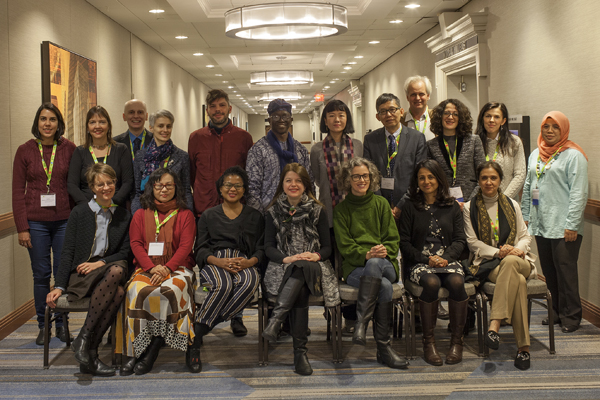
CAA-Getty Scholars at the 2019 Annual Conference in New York. Photo: Ben Fractenberg
The Getty Foundation has awarded CAA a grant to fund the CAA-Getty International Program for a ninth consecutive year. The Foundation’s support will enable CAA to bring twenty international visual-arts professionals to the 108th Annual Conference, taking place February 12-15, 2020 in Chicago. Fifteen individuals will be first-time participants in the program and five will be alumni, returning to present papers during the conference. The CAA-Getty International Program provides funds for travel expenses, hotel accommodations, per diems, conference registrations, and one-year CAA memberships to art historians, artists who teach art history, and museum curators.
The application portal is now open. Grant guidelines and the 2020 application can be found here.
“The Getty Foundation is proud to continue its commitment to the CAA-Getty International Program and offer support that brings together diverse scholars from around the world,” says Joan Weinstein, acting director of the Getty Foundation. “CAA’s dedication to this joint program strengthens the annual conference and builds the field of art history as a global discipline.”
Since the CAA-Getty International Program’s inception in 2012, it has brought over 120 first-time attendees from 46 countries to CAA’s Annual Conference. Historically, the majority of international registrants at the conference have come from North America, the United Kingdom, and Western European countries. The CAA-Getty International Program has greatly diversified attendance, adding scholars from Central and Eastern Europe, Russia, Africa, Asia, Southeast Asia, the Caribbean, and South America. The majority of the participants teach art history, visual studies, art theory, or architectural history at the university level; others are museum curators or researchers.
One measure of the program’s success is the remarkable number of international collaborations that have ensued, including an ongoing study of similarities and differences in the history of art among Eastern European countries and South Africa, attendance at other international conferences, publications in international journals, and participation in panels and sessions at subsequent CAA Annual Conferences. Former grant recipients have become ambassadors of CAA in their countries, sharing knowledge gained at the Annual Conference with their colleagues at home. The value of attending a CAA Annual Conference as a participant in the CAA-Getty International Program was succinctly summarized by alumnus Nazar Kozak, Senior Researcher, Department of Art Studies, National Academy of Sciences of Ukraine “To put it simply, I understood that I can become part of a global scholarly community. I felt like I belong here.”
Read our Member Spotlight with Nazar Kozak.
About the Getty Foundation
The Getty Foundation fulfills the philanthropic mission of the Getty Trust by supporting individuals and institutions committed to advancing the greater understanding and preservation of the visual arts in Los Angeles and throughout the world. Through strategic grant initiatives, it strengthens art history as a global discipline, promotes the interdisciplinary practice of conservation, increases access to museum and archival collections, and develops current and future leaders in the visual arts. It carries out its work in collaboration with the other Getty Programs to ensure that they individually and collectively achieve maximum effect.



